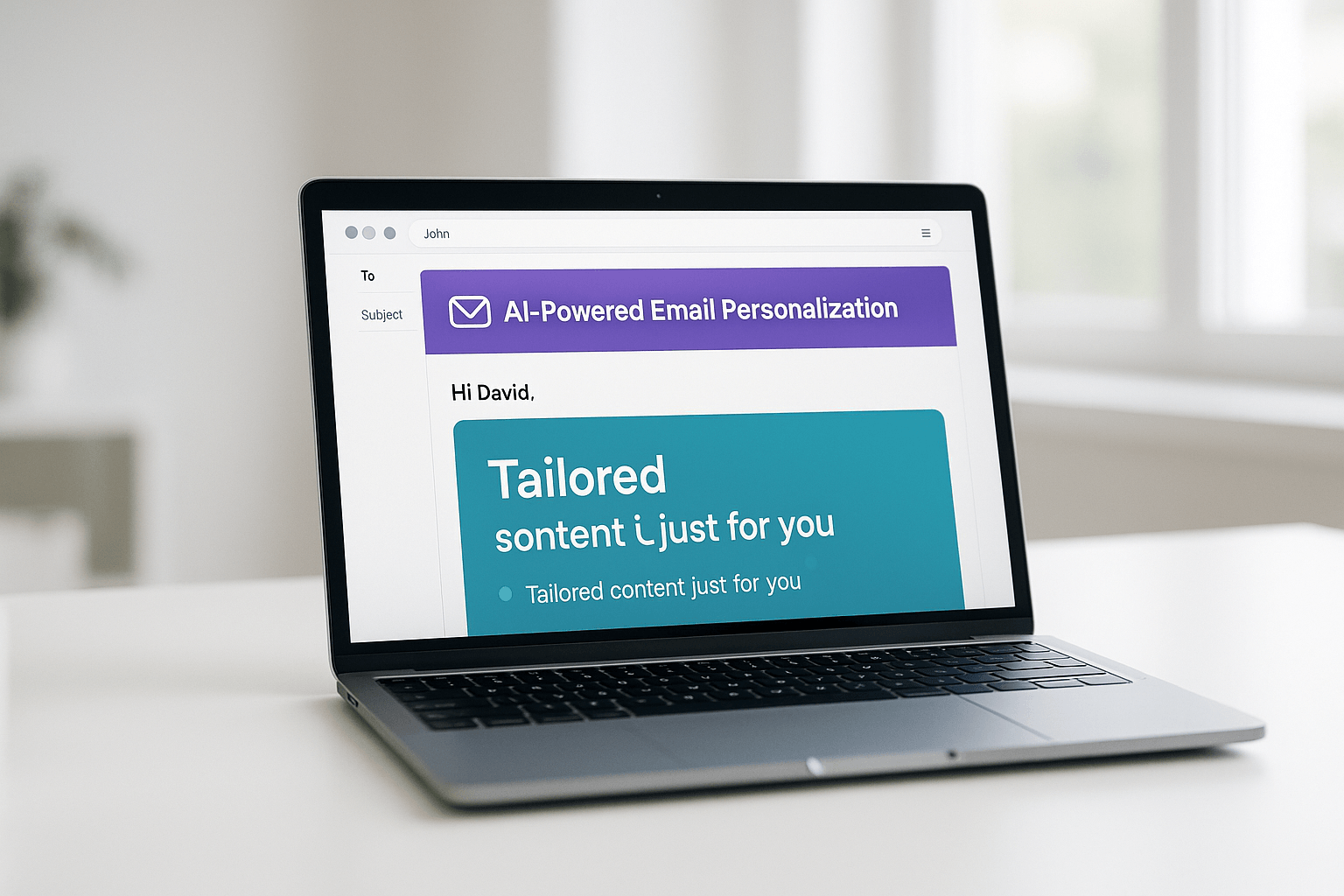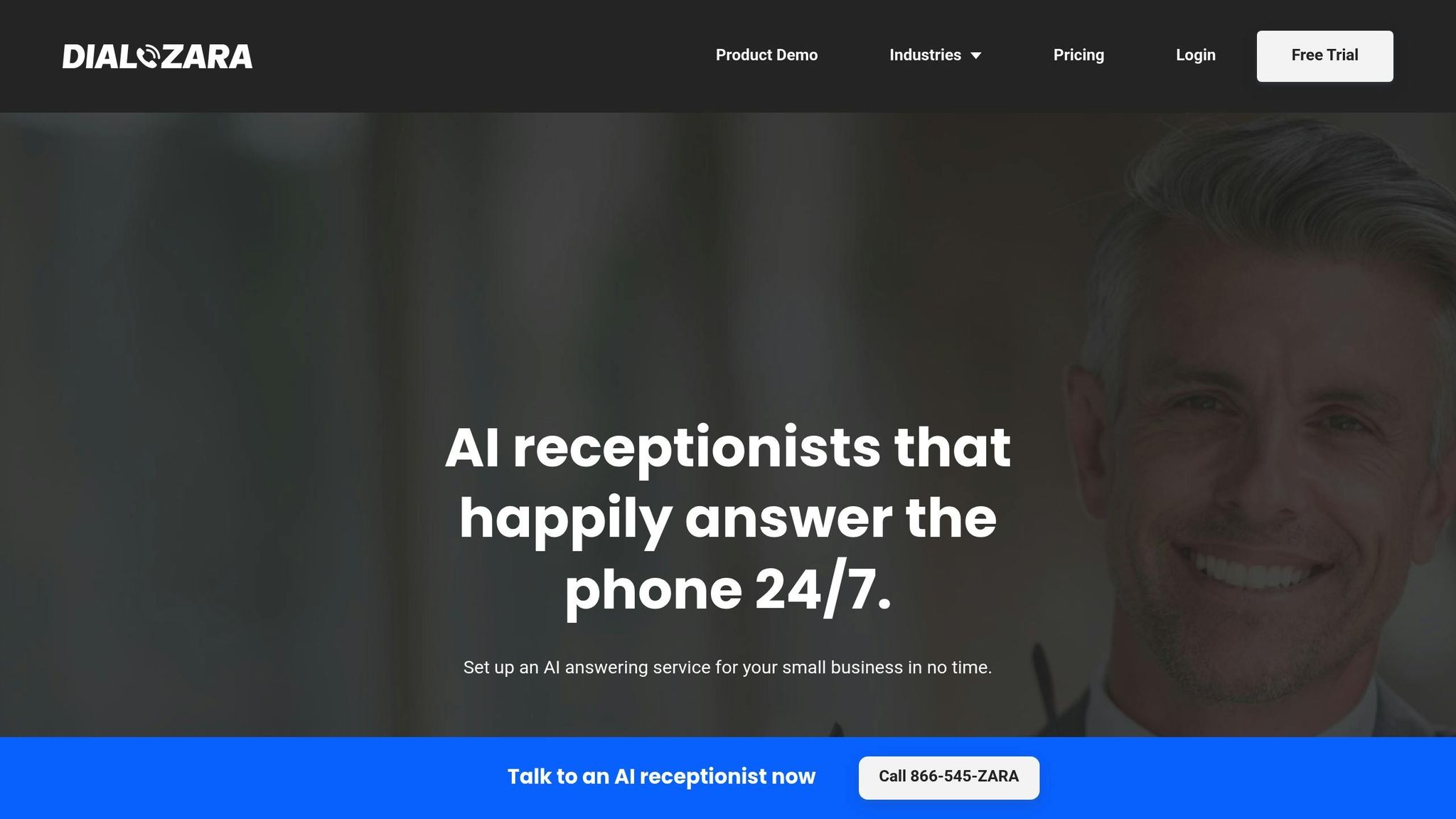
AI-Powered Email Personalization: Best Practices
Unlock the potential of AI-driven email personalization to boost engagement, enhance customer connections, and maximize ROI through tailored messaging.

Written by
Adam Stewart
AI-driven email personalization helps businesses send relevant, tailored messages that boost engagement, trust, and ROI. Here’s what you need to know:
- Why It Matters: Personalized emails improve open rates, click-through rates, and customer loyalty while saving time through automation.
- How It Works: AI analyzes customer behavior, creates tailored content, optimizes send times, and adapts campaigns in real time.
- Key Features:
- Data Analysis: Segments audiences based on behavior and preferences.
- Dynamic Content: Crafts subject lines, product recommendations, and offers.
- Smart Timing: Sends emails when recipients are most likely to engage.
- Implementation Tips:
- Set measurable goals (e.g., increase open rates by 15%).
- Ensure compliance with privacy laws (e.g., consent management).
- Test and refine strategies with A/B testing and analytics.
- Advanced Integration: Combine email with SMS and voice channels for consistent, cross-platform communication.
AI simplifies email marketing, making it more effective and scalable for small and medium-sized businesses. Start small, focus on data-driven strategies, and let AI continuously improve your results.
Key Elements of AI Email Personalization
AI is reshaping email marketing by breaking down the process into specific, actionable components. These key elements work together to create targeted campaigns that boost engagement and deliver results.
Customer Data Analysis and Segmentation
AI takes raw customer data and turns it into meaningful insights. By analyzing factors like purchase history, browsing behavior, engagement metrics, demographics, and lifecycle stages, AI identifies patterns and trends. For instance, it can reveal when and how customers interact with your content, allowing marketers to create precise segments for tailored messaging. This level of insight ensures your emails resonate with the right audience at the right time.
Automated Content Creation
With natural language processing (NLP), AI goes beyond generic greetings to craft personalized content. Here are some examples:
- Dynamic subject lines that reference recent interactions
- Tailored product recommendations based on browsing history
- Custom offers aligned with individual purchase habits
- Content that matches the recipient's engagement preferences
Here’s a quick breakdown of how AI enhances email content:
| Content Element | AI Personalization Approach | Benefit |
|---|---|---|
| Subject Lines | References recent product views | Higher open rates |
| Body Content | Matches user's browsing history | Increased click-through rates |
| Product Recommendations | Based on purchase patterns | Higher conversion rates |
But personalization doesn’t stop at content - it’s also about sending the email at the perfect time.
Smart Timing and Analytics
Timing is everything, and AI excels at figuring out when recipients are most likely to engage. By analyzing historical data, AI identifies patterns in:
- Open and click behavior
- Time zone preferences
- Day-of-week engagement
- Recent activity
The system learns from these behaviors, continuously refining send times. For example, if a customer consistently opens emails during their lunch break, AI ensures future emails arrive during that window. This data-driven timing strategy ensures your emails land in inboxes when they’re most likely to be seen and acted upon.
Implementation Guidelines
Setting up AI-powered email personalization requires careful planning to ensure it runs smoothly, complies with regulations, and delivers strong results. Here's a guide to making it work effectively.
Define Personalization Goals
Start by setting clear, measurable goals that align with your business objectives. Here’s a quick look at some common targets:
| Goal Type | Example Target | Measurement Method |
|---|---|---|
| Engagement | Increase open rates by 15% | Track 90-day performance |
| Conversion | Boost click-through rates by 20% | Monitor user interactions |
| Revenue | Improve email-driven sales by 25% | Track attribution data |
Use your historical data as a starting point. For example, if your current open rate is 18%, aim for incremental improvements over a set period. This not only helps you measure progress but also validates your investment in AI.
Once your goals are in place, ensure your data collection and usage meet privacy standards before rolling out your strategy.
Data Privacy Requirements
AI-driven personalization needs to adhere strictly to privacy regulations. Keep these key areas in mind:
- Consent Management: Use clear opt-in processes that inform customers about how their data will be used. Make sure your privacy policy explicitly addresses AI-driven personalization.
- Data Security: Protect customer data with encryption and secure transmission protocols to safeguard sensitive information.
- Access Controls: Limit access to customer data within your organization and conduct regular audits to ensure compliance and maintain data integrity.
Only collect the data you need to meet your goals. Secure handling of this information is essential for building trust and creating a strong foundation for testing and optimization.
Testing and Improvement
Once your goals are set and your data is secure, it’s time to refine your strategy through continuous testing.
Experiment with A/B testing on key elements like:
- Subject line variations
- Levels of content personalization
- Optimal send times
- Placement of calls-to-action
Track performance using metrics such as open rates, click-through rates, and conversions. For example, testing subject lines alone can significantly impact click-through rates.
Incorporate control groups to clearly measure the effect of personalization. Use AI analytics to uncover trends in successful campaigns and apply those insights to future strategies. For instance, if morning emails consistently perform better for a specific audience segment, adjust your scheduling to reflect that.
Look beyond immediate results and monitor long-term metrics like customer lifetime value and retention rates. This broader perspective helps balance short-term wins with sustainable growth over time.
Multi-Channel Integration
Bringing together communication across multiple platforms creates a smoother and more connected experience for customers. When businesses coordinate their messaging across various touchpoints, they can amplify the effectiveness of their personalization strategies.
Cross-Channel Personalization
To personalize effectively across channels, businesses need to align customer data and messaging across platforms like email, SMS, and voice. This approach ensures consistency while boosting engagement.
Here’s how different channels can work together to enhance personalization:
| Channel | Personalization Opportunity | Integration Benefit |
|---|---|---|
| Behavioral triggers | Encourages targeted follow-ups across platforms | |
| Voice | Customer preference data | Shapes email content and timing |
| SMS | Response tracking | Facilitates multi-channel engagement flows |
For example, when a customer shares specific preferences during a phone call, that information can automatically update their email profile. This ensures future communications are more relevant to their needs.
Voice integration adds another layer of precision to these cross-channel benefits.
Dialzara Voice Integration

By incorporating advanced voice interactions, businesses can take their personalization efforts even further. Dialzara's AI voice technology seamlessly connects with existing systems to maintain consistent communication across platforms.
Bobby James Fournier explains:
I've found Dialzara to be incredibly efficient and authentic.
Recent data shows that while 60% of customers prefer calling local businesses, only 38% of calls are answered. Dialzara’s 24/7 AI answering service bridges this gap and integrates with email campaigns to:
- Collect valuable customer insights during calls to improve email personalization
- Use call data to segment email audiences more effectively
- Ensure messaging stays consistent across channels
- Automatically send personalized email follow-ups based on call outcomes
With AI voice data feeding directly into email systems, businesses can keep their communications relevant and targeted. This integration creates a unified strategy, combining insights from voice and email to better engage and connect with customers.
sbb-itb-ef0082b
Performance Tracking and Growth
Keep tabs on AI email personalization efforts using detailed metrics and scalable analytics to ensure success.
Success Metrics
To measure the effectiveness of AI-driven email personalization, focus on key performance indicators (KPIs) that align with your business goals. These metrics should capture both engagement and revenue outcomes.
| Metric Category | Key Indicators | Target Improvement |
|---|---|---|
| Engagement | Open Rate, Click-Through Rate | 26% increase with name personalization |
| Conversion | Sales, Sign-ups, Downloads | 6x higher transaction rates |
| Revenue | Revenue per Email, ROI | 760% revenue boost |
| Quality | Unsubscribe Rate, Spam Reports | Below industry benchmarks |
For a more advanced approach, consider AI-specific metrics like how well your segmentation works or how accurate your content recommendations are. These insights can help fine-tune your strategies over time.
Growth Planning for SMBs
Small and medium-sized businesses (SMBs) can scale AI personalization by leveraging well-organized customer data. A Customer Data Platform (CDP) is a game-changer for this process, as it consolidates data from multiple touchpoints to:
- Build detailed customer profiles
- Automate personalization workflows
- Streamline content creation
- Enable dynamic content assembly
Recent research from Mailmodo (2025) highlights that segmented campaigns lead to better engagement rates. The secret lies in adopting scalable tools and strategies that grow alongside your business.
AI Learning Process
AI thrives on feedback, using it to continually improve its personalization capabilities. When paired with human oversight, AI gains the contextual understanding needed for smarter, more strategic adjustments.
Here’s how the learning cycle works:
- Initial data segmentation: Organize customer data into meaningful groups.
- Campaign deployment: Launch personalized campaigns tailored to each segment.
- Pattern recognition: Analyze results to identify trends and behaviors.
- Strategy refinement: Adjust tactics based on insights gained.
Most businesses notice a marked improvement in personalization accuracy within 3–6 months of using AI. Regular audits are essential to maintain quality and address potential issues before they escalate.
To get the most out of AI’s learning process, focus on:
- Clean, well-organized data
- A sufficient volume of customer interactions
- Routine performance evaluations
- A balanced mix of automation and human input
This ensures your AI-driven personalization stays effective and aligned with your goals.
Conclusion
AI-powered email personalization has proven to be a game-changer for driving revenue through targeted and meaningful communication. To make the most of this technology, businesses should focus on three main areas:
- Data-Driven Decisions: Use customer behavior data to create precise audience segments.
- Continuous Learning: Adapt and improve strategies by leveraging AI feedback over time.
- Scalable Growth: Choose tools that can grow alongside your business needs.
By combining advanced data analytics with multi-channel integration, small and medium-sized businesses (SMBs) can take the first steps by setting clear objectives, ensuring data privacy, and running thorough tests. AI’s ability to analyze customer behavior, automate personalized content, and fine-tune delivery timing makes it an essential tool for building stronger connections with customers.
As AI technology continues to evolve, offering more advanced cross-channel capabilities and better performance tracking, businesses will gain access to increasingly sophisticated tools for engaging their audience. The secret to success? Start small, monitor the results, and expand based on what works best.
FAQs
How does AI-powered email personalization boost engagement and maximize ROI for my business?
AI-driven email personalization gives your business an edge by customizing messages based on each customer's preferences and behaviors. By examining data like past purchases, browsing habits, and previous interactions, AI can create content that feels relevant and engaging. This level of personalization often leads to better open rates, more clicks, and increased conversions.
Beyond boosting engagement, this strategy maximizes your ROI by making your marketing efforts more precise and impactful. Rather than sending out generic emails, AI helps you deliver timely, meaningful messages that strengthen customer relationships and produce tangible results.
How can businesses ensure compliance with privacy laws when using AI for email personalization?
To comply with privacy laws like GDPR and CCPA when using AI for email personalization, businesses should prioritize a few critical practices:
- Get clear consent: Make sure users give explicit, informed permission before their data is collected or used for personalized emails.
- Collect only what’s needed: Stick to gathering just the data required for personalization, avoiding unnecessary or sensitive details.
- Be transparent: Clearly explain in your privacy policy how customer data is collected, stored, used, and protected.
- Offer opt-out options: Make it simple for users to opt out of personalized emails or data collection if they choose.
Following these steps not only ensures compliance but also helps establish trust with your audience. Regularly revisit and fine-tune your policies to keep up with changing legal standards.
How can small and medium-sized businesses use AI to enhance email personalization effectively?
AI has the power to transform how small and medium-sized businesses (SMBs) approach email personalization. By diving into customer data and creating tailored content, businesses can send messages that truly connect with their audience. Here are some practical tips to make the most of AI for email campaigns:
- Tap into behavioral data: AI can analyze customer actions like purchase history, browsing habits, or how they engage with previous emails. This helps in crafting messages that feel more relevant and personal.
- Break down your audience: With AI, you can segment your audience into smaller, focused groups, making it easier to address their specific interests and needs.
- Experiment with A/B testing: AI tools allow you to test different subject lines, email content, or layouts to find out what resonates best with your audience.
- Perfect the timing: AI can figure out the best times to send emails, ensuring your message lands when recipients are most likely to engage.
Incorporating AI into your email strategy can help SMBs deepen customer connections, boost engagement, and achieve better results from their campaigns.
Summarize with AI
Related Posts
AI Email Personalization: How It Works
Learn how AI email personalization enhances customer engagement through tailored content, optimizing send times, and improving metrics for businesses.
AI Email Automation for Customer Service: Guide
Learn how to set up AI email automation for customer service, automate email responses, handle complex inquiries, and measure performance. Enhance customer satisfaction and operational efficiency.
9 Ways AI Personalization Boosts Customer Engagement
Discover how AI personalization boosts customer engagement through personalized product recommendations, tailored content, predictive analytics, chatbots, and more.
9 AI Personalization Strategies for 2024
Discover 9 AI personalization strategies for 2024 that can boost customer satisfaction, engagement, and revenue. Learn how AI-powered personalization can shape customer experiences.
